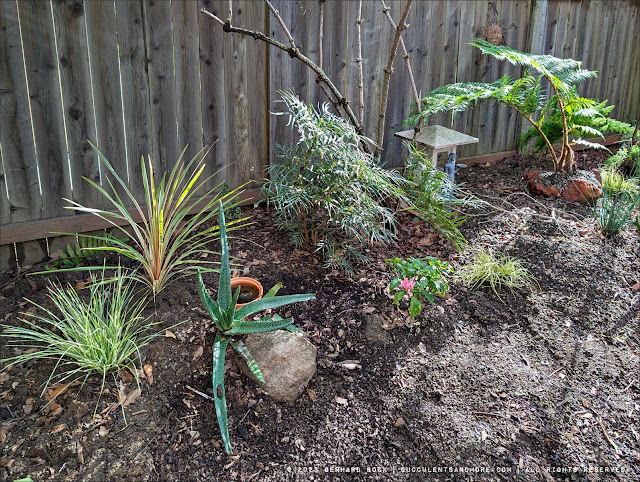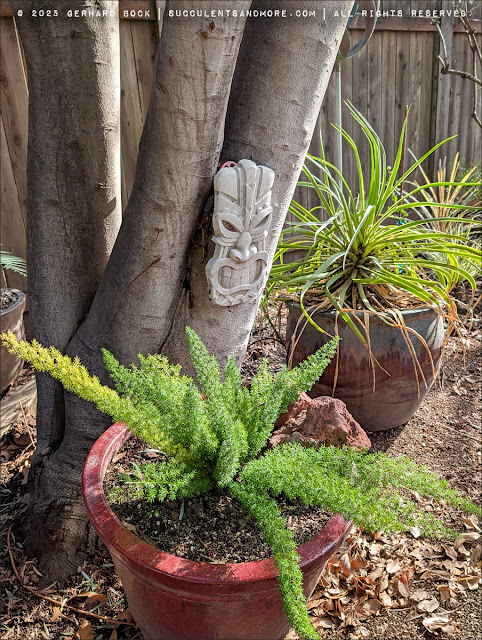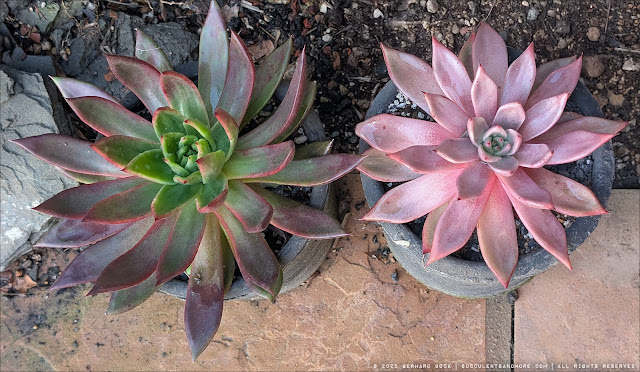In my previous post I showed you some highlights from the front yard. Now let’s do the same for the backyard.
To be honest, I’ve neglected the backyard for a long time, instead putting most of my energy into the front yard. Much of the backyard is in dry shade, and finding plants that do well in that kind of situation has been challenging and often disappointing.
A few months ago, I started to build new succulent mounds (sneak peek here). They’re fully planted now, and I’ll have an update soon. In addition, I’ve begun to revamp other areas, including the bed we see from the kitchen and living room. I’ve decided to give this bed more water in the summer and have chosen plants that will provide a “lusher” look – quite different from the plant palette in the front yard:
 |
| We see this bed from both the kitchen and the living room. I’ve been replanting it with “lusher” plants. |
 |
| A few closeups of the same area |
 |
| Plants include Agave desmetiana, fern-leaf lavender (Lavandula multifida), foxtail fern (Asparagus densiflorus ‘Myersii’), Japanese holly fern (Cyrtomium falcatum), California gray rush (Juncus patens), variegated Japanese sedge (Carex oshimensis ‘Evergold’), Gasteria acinacifolia, Tasmanian tree fern (Dicksonia antartica), Brazilian plume flower (Justicia carnea), Mahonia eurybracteata ‘Soft Caress’, Cordyline australis ‘Torbay Dazzler’, Lomandra ‘Arctic Frost’, and Correa ‘Gwen Elliot’. |
 |
| Most plants are still small so not as impressive as I’m hoping they will eventually be |
 |
| Mahonia oiwakensis (back) and Agave dasylirioides (in container) are at the left end of the bed |
 |
| Asparagus densiflorus ‘Myersii’ (left) and Agave dasylirioides (right) |
 |
| South end of the backyard. The L-shaped sidewalk bed in the front is on the other side of the fence. |
 |
| Agave attenuata ‘Ray of Light’ with several pups. I also have an A. attenuata ‘Boutin Blue’ and a regular A. attenuata planted nearby. They’ve never sustained any winter damage; the fence (on the right in the photo above) provides just enough protection. |
 |
| Mound #2. The upended cart serves as anchor point for the tarp. |
 |
| Tarp lit up at night by the motion sensor lights on the fence |
 |
| Aloe helenae, Agave geminiflora, and Agave ovatifolia ‘Vanzie’ |
 |
| Agave ovatifolia ‘Vanzie’ |
 |
| Not a pretty sight per se, but the promise of what’s to come: We just removed the dying Japanese maple on the left and will eventually clear out the entire bed you see above. Our house needs painting, and once that is done, I will plant a grouping of totem pole cactus (monstrose form of Lophocereus schottii). |
 |
| First Massonia pustulata flower of the year. There are four of them in this pot now. For 9+ months of the year, the pot looks empty. Then, in early winter, the leaves start to emerge, followed by the flowers. |
 |
| Colorful Echeveria agavoides cultivars |
I’ll have more posts soon about the changes happening in the backyard.
© Gerhard Bock, 2025. All rights reserved. To receive all new posts by email, please subscribe here.






















Protecting from rain would be a novel occurrence here! But with the amount you get in winter I am sure it is best to do! So many wonderful plants, Gerhard! I find the Massonia pustulata very interesting. I have friends here that grow it but the leaves do not have ridges like yours. Maybe the species is different? And I would give anything to be able to grow those Echeveria agavoides! I can't wait for your next installment!
ReplyDeleteThere are other Massonia species with smooth leaves. This one (pustulata) is the most common around here.
DeleteThe ones here might be Massonia echinata. Actually, I think it has ridges but very pale on the leaves.
DeleteOh, this is so cool. The totem pole cactus will look SO good against the house, great idea. Do you leave your epiphyllums & tillandsia outside all year? I have some out but cover when it's in the 30's, but they do seem tougher than I'm giving them credit for. Your new mounds are great with all that rock, this will be so fun to see everything grow & change.
ReplyDeleteEpis and tillandsias stay outside all year, like all my bromeliads. They're protected a bit by the fence, and the wimpy ones have long died :-)
DeleteImpressive as always. I love the 'Red Chestnut' bromeliad and the Massonia. Even covered, your new mounds look good!
ReplyDeleteThanks, Kris. You should be able to find Vriesea 'Red Chestnut' in the houseplant section. It's quite common. Mine has never gotten any winter protection, and it's been fine.
DeleteLots to love here! I am thrilled you planted a Dicksonia antarctica, how long has it been in the ground? I also love your assorted jungle cactus and bromeliads, and I'm so jealous you can grow them all in the ground. Will your house stay the same color, or is there change in the air?
ReplyDeleteThe Dicksonia antarctica was planted about a month ago. It was a decent-sized plant already, stuffed into a 1 gal can.
DeleteHouse color: It won't be the same color, but I have no idea what it will be. Maybe a sage green? I'd like gray, but that might be too depressing.
When you mentioned painting your house, the first thing I thought of was a sage green! I think it would be fabulous! Gray ... not so much!
DeleteLOL, I know, gray is a non-starter.
DeleteIt's a lovely new bed and the small plants will soon fill in. I didn't catch the names of the established trees, especially the one holding the hanging plants: what a great service it provides. Also, what's the bare shrub right behind mahonia soft caress?
ReplyDeleteIn this post, for the first time, there are plants that grow in my north Seattle garden.
Chavli
The tree holding the hanging plants is a chaste tree (Vitex agnus-castus), and the bare shrub behind the mahonia is a 'Black Lace' elderberry - that one would grow in your garden for sure.
DeleteLove all your new plantings. Thought I was the only one who loves both cactus and ferns. Watch that holly fern. If it goes more than 10 seconds without water the tips of all the leaves die. I've done this too many times because my holly ferns are under the eves of our house and I forget that they don't get any rain.
ReplyDeletePriscilla
As my friend Loree (danger garden) says, ferns are the new succulents :-)
DeleteAgave dasylirioides -- who knew? The breadth of your collecting continues to astonish.
ReplyDeleteAgave dasyliroides isn't the most attractive aloe, but it's one of the few species that doesn't die after flowering (mine flowered a few years ago).
DeleteThis is one of my favorite stages of gardening. When you've got a whole bunch of new plants in place and all there is left to do is wait and see what thrives versus what doesn't. I bet everything will fill in within a year or two.
ReplyDeleteI'm with you. I love the anticipation. Seeing how everything will develop.
DeleteI spy a young Cycas debaoensis in the blue chair photo, and a few more cycads in other pictures, hooray!
ReplyDeleteEagle eyes! The debaoensis is almost 10 years old--I guess it's still young :-)
DeleteI have a few other cycads in the backyard. The survivors, I should say. I trialed a bunch of ceratozamias and zamias and only one ceratozamia (hildae) made it.